MXA RACE TEST: THE REAL TEST OF THE 2021 KTM 350SXF
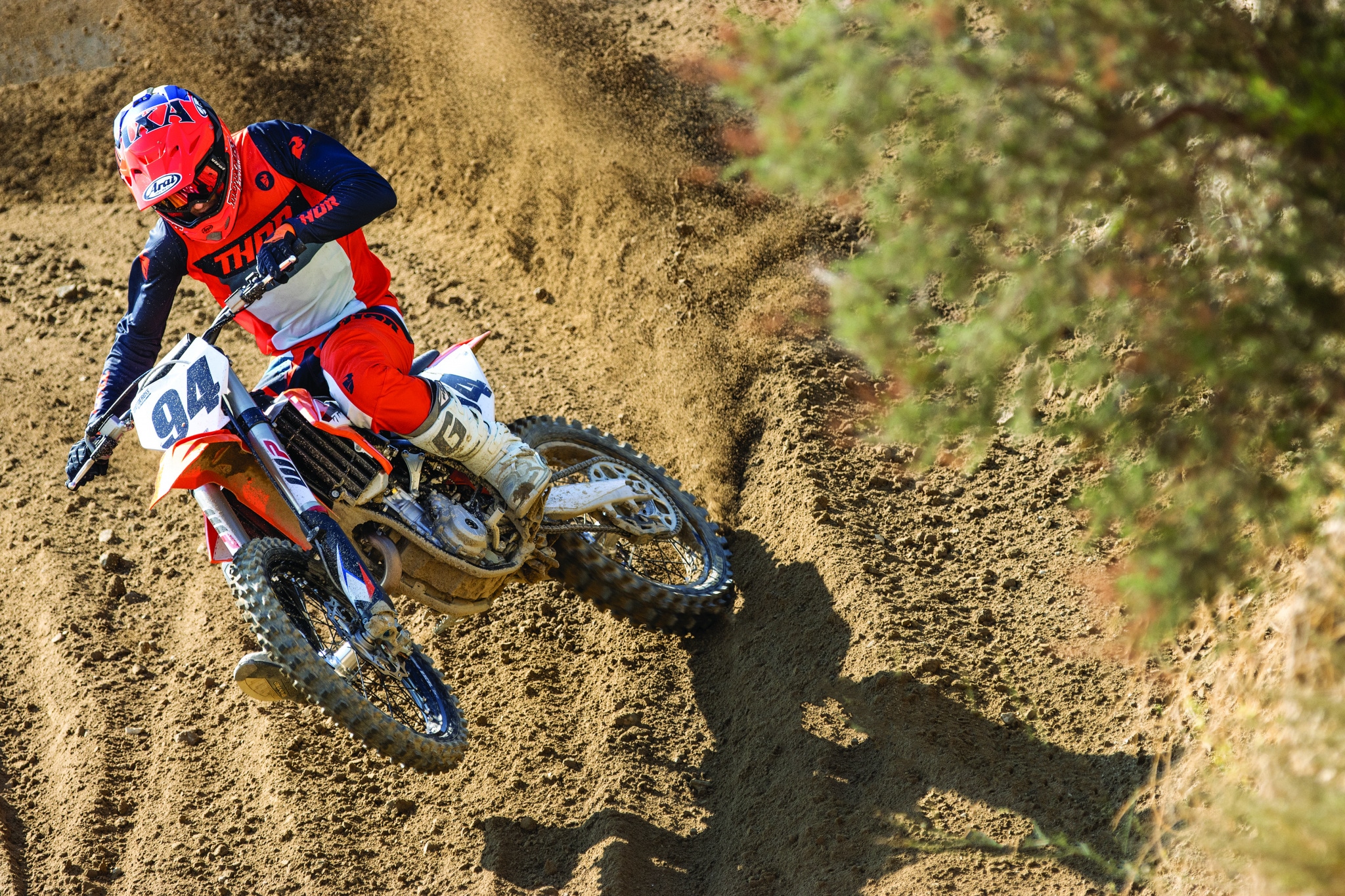
Q: FIRST AND FOREMOST, IS THE 2021 KTM 350SXF BETTER THAN THE 2020 KTM 350SXF?
A: Yes, but the changes, which are extensive, are not focused on power, handling, brakes, clutch, gearing or ergonomics. In these areas, the 2020 and 2021 KTM 350SXFs are almost identical. We think that KTM can be excused for coasting on R&D changes to the running gear of the 350SXF. There are three reasons why KTM didn’t feel compelled to punch up the 2021’s power, brakes, clutch, gearing and ergonomics.
(1) History. In last year’s 2020 KTM 350SXF test, we said, “Broken down to its basics, the KTM 350SXF is the best all-around midsize motocross bike of 2020. The technological leaps that the 350SXF has made since it was introduced in 2011 are dazzling. And that is what you’ll be in the saddle of a 2020 KTM 350SXF—dazzling.”
(2) Competitors. The 2021 KTM 350SXF isn’t chasing anyone. There isn’t a CRF350, YZ350F, KX350 or RM-Z350 breathing down its neck. KTM owns the 350cc motocross market (well, it shares it with its Husqvarna FC350 stablemate), and KTM has no reason to chase its own tail.
(3) Problem-solving. The KTM R&D department didn’t want to waste time fixing what wasn’t broken on the 350SXF. Instead, they put all their attention on the one area where they get the most flak—the WP XACT air forks. And, it is in the suspension performance that KTM made the greatest strides forward.
Q: WHAT WAS KTM TRYING TO ACCOMPLISH WITH ITS 2021 SUSPENSION MODS?

A: For 2021, KTM’s R&D department tasked WP with building an air fork that delivered the feel of a coil-spring fork while maintaining the 3-pound weight advantage, infinite adjustability and tuneability of an air fork. You would be forgiven for thinking that this is an impossible task, given that Showa and Kayaba failed miserably with the SFF and PSF air forks four years ago. But, WP had the advantage of learning from its competitors’ mistakes.
WP’s take on air forks is so different from Showa’s and Kayaba’s concept that you almost think they are existing in opposite spheres. Back in 2017, the original WP AER fork didn’t try to reinvent the wheel. WP just replaced the coil springs with air‚ recycled the air to control the fork on both the compression and rebound stroke, and split the fork legs into an air pressure leg and a damping leg. It was simple, and it was light, but it had challenges due to the nature of air springs versus coiled steel springs.
To meet that challenge head-on, WP redesigned every internal piece of the 2021 XACT fork, all with an eye towards lessening mid-stroke harshness, improving front tire contact, increasing overall comfort, decreasing the compression spike at the end of the stroke and eliminating any spikes in the damping curve with internal restrictions.
It was a big task, one that was considered impossible by Showa and Kayaba. Here is what WP did to its 2021 forks.
Q: WHAT CHANGES DID WP MAKE TO LESSEN MID-STROKE HARSHNESS?
A: In short, WP focused on the “unintentional forces” that wreaked havoc on fork performance. You can’t make a fork more fluid without studying the flow dynamics that take place inside the damping leg. WP added four new design features to the 2021 XACT fork’s damping.
(1) Oil-bypass notches. There are a lot of sliding surfaces, seals and bushings inside a fork’s damping system. Most of these parts are speed sensitive in that they work the same no matter what position they are in the fork tube, but they impart different forces when they are in motion. For example, a fork moves the fastest in the first half of its travel, and that added speed builds up pressure as the fork is compressed. To help bleed off this pressure, WP added three oil-bypass notches to reduce oil-pressure peaks and level out the damping in the first part of the fork’s stroke.
(2) Trampoline valve. Unlike on a traditional mid-valve shim stack, WP added a “trampoline shim,” so called because, unlike a normal shim that is tightly packed in by other shims and pistons, the trampoline shim has room to bend. It is given room to bend by being located above a small cavity that allows more damping in the mid-valve without making the damping stiffer at the end of the stroke.
(3) Bump stop. WP dropped the bottoming cone from the 2021 XACT damping leg. On most forks, there is a cone-shaped device that interfaces with the fork’s moving parts to progressively slow the fork by squeezing the fork oil in tighter and tighter spaces as the cone-shape decreases the oil volume. Because air pressure has what is known as a J-curve as it is compressed to the point of being non-compressible, it doesn’t need a bottoming cone. The air pressure will stop the forks without help; however, WP put a 1/2-inch-thick rubber bump stop to cushion the end of the stroke.
(4) Rebound clicker. You don’t need a screwdriver to adjust the rebound amping and you don’t have to lay in the dirt—just reach down under the fork and turn the clicker by hand.
Although WP prefers to say that three of these four changes help with unintentional forces that come from squeezing oil to provide damping, it is obvious that taking the edge off the damping in the first half of the stroke allows the front tire to work better over undulating ground, while the trampoline valve lessens the spike when the shim stack is over-pressurized. The lack of a bottoming cones not only eliminates the last oil spike, it also allows enough room for WP to put a finger-controlled rebound clicker on the bottom of the damping leg to make adjusting the rebound damping easier.

Q: WHAT CHANGES DID WP MAKE TO LESSEN AIR PRESSURE SPIKES?
A: The air in an “air fork” is used as a spring. It was first used by motocross racers in late 1973 when local racers took the coil springs out of their forks, drilled holes in the fork caps to install Schrader valves, and filled their forks with air. Yamaha joined the air-fork parade in 1976 with its “speedo and tach” air forks. Air makes an excellent spring. It is light, can be adjusted with a tire pump and can be made stiff enough to resist bottoming; however, when you trap air inside a fork tube, it is only your friend when it is used to slow the compression of the fork. Once the fork travels as far up as it can go, the built-up air pressure becomes your enemy. That trapped air pressure will reverse directions and blast the fork leg downward like a projectile. This is known as “topping out,” because the fork extends so fast that it clanks violently when fully extended. Topping out was the curse that killed the air-fork movement in 1976.
In 2013, air forks made a comeback with the arrival of Kayaba PSF and Showa SFF air forks. Their claim to fame was that they offered a solution to topping out. The solution was to add a negative air chamber that held enough air pressure to resist the rebound stroke. In simplistic terms, that meant that the fork had a second air fork at the bottom of the fork legs that worked in the opposite direction. It added complexity. Now, instead of having Schrader valves on the top of the fork, they had Shraeder valves top and bottom—and the rider had to figure out the correct ratio of air pressure in the main chamber (top of the fork) and negative chamber (on the bottom of the fork) to make the fork work properly. The Showa SFF fork had six Schaeder valves to adjust. It was so complicated that riders refused to buy bikes with PSF or SFF forks—and by 2017 the manufacturers dropped air forks from their model lines to keep consumers from complaining.
That is when KTM introduced its WP AER air fork. WP’s ace up its sleeve was that the Austrian engineers had figured out how to recycle air in the main chamber so that it would also dampen the fork on its return stroke (much as a modern rifle uses excess gases to reload the next shell). This was achieved by putting an air crossover bleed slot near the middle of the compression stroke to allow the pumped-up air pressure in the main chamber to leak over to the rebound side of the fork to resist downward acceleration of the fork tubes. It was an ingeniously simple idea. And for 2021, it was improved by two relatively simple modifications:
(1) Crossover bleed slot. For 2021, WP doubled the length of the crossover bleed slot in coordination with enlarging the size of the negative air chamber air space for more progressive air pressure on the negative side. The longer crossover slot allows the fork to move farther before the spring pressure builds up. The effect is to make the compression stroke more fluid.
(2) Air seal. Much as the oil-bypass notches relieve oil pressure buildup in the damping leg, WP decided to do the same thing on its air pressure leg. WP put three bypass holes in the air seal to lessen air pressure spikes. These holes allowed excess air to leak back down into the negative chamber.
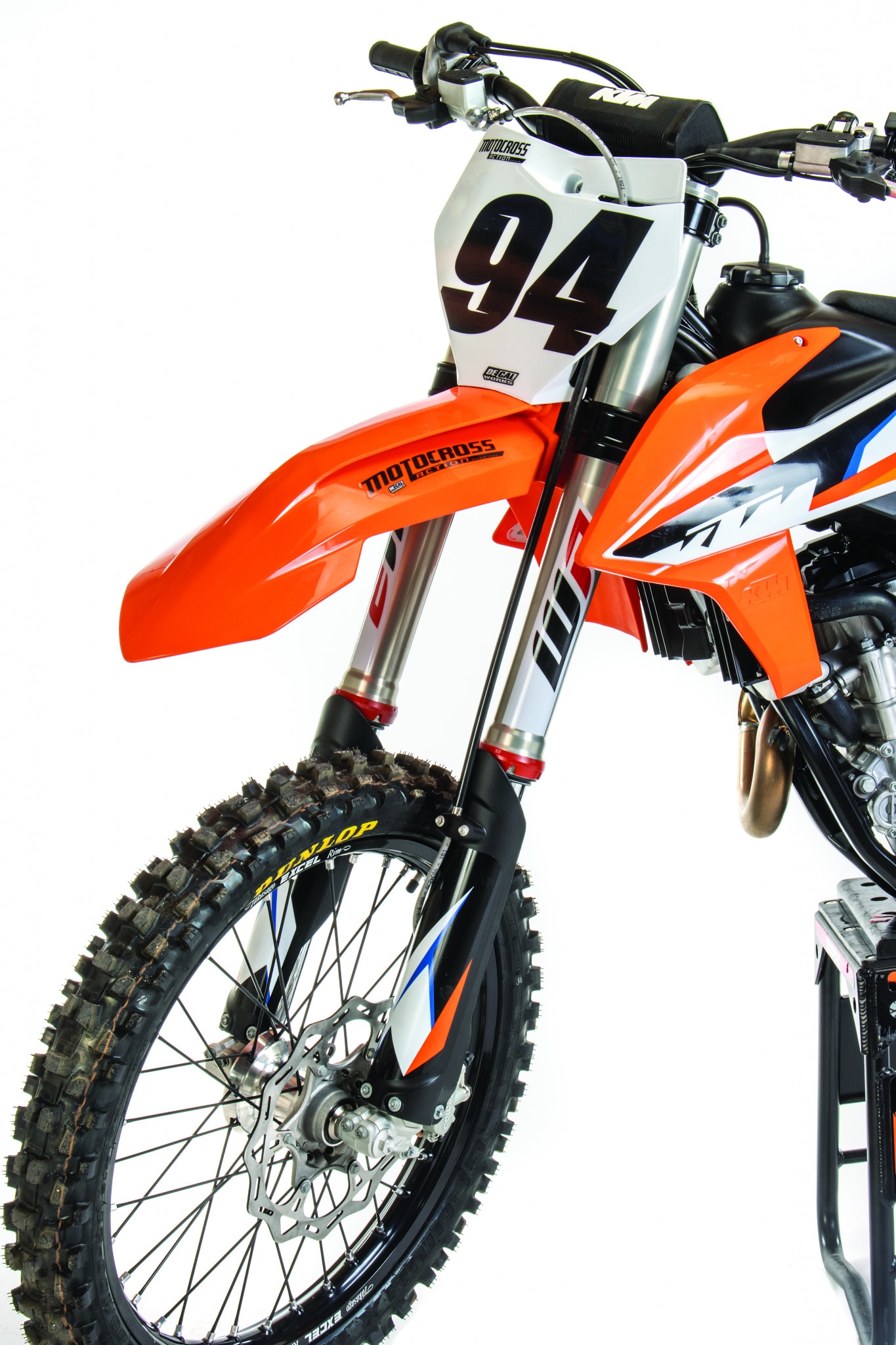
Q: HOW DO THE NEW WP XACT FORKS WORK?
A: The internal modifications were designed to make the stroke more fluid, reduce pressure spikes, bleed off excess oil pressure and reduce the effects of an air fork’s hyper-progressive spring rate at the end of the stroke. Every MXA test rider loved the new WP air forks. The front tire followed the ground like with coil spring forks, without any of the lift-off common with air forks. The complete stroke was smoother, delivered more feedback and felt suppler. We understand that there are lots of WP air-fork owners who have been unhappy since AER forks were first introduced in 2017, but for 2021, KTM focused its complete R&D program on addressing all the complaints about its WP Xact air forks.
Faster MXA Pro test riders ran the recommended 10.6 bar (154 psi) or higher. Intermediates ran 10.3 bar (150 psi). Fast Novices ran 10.0 bar (145). Novices and Vets ran 9.6 bar (140 psi). There were test riders who ran over 11.0 bar and riders who ran under 9.6 bar. KTM used to insist that its recommended air pressure was the best, but now KTM knows that the big plus of air forks is giving the rider the freedom to go as low or high as he wants.
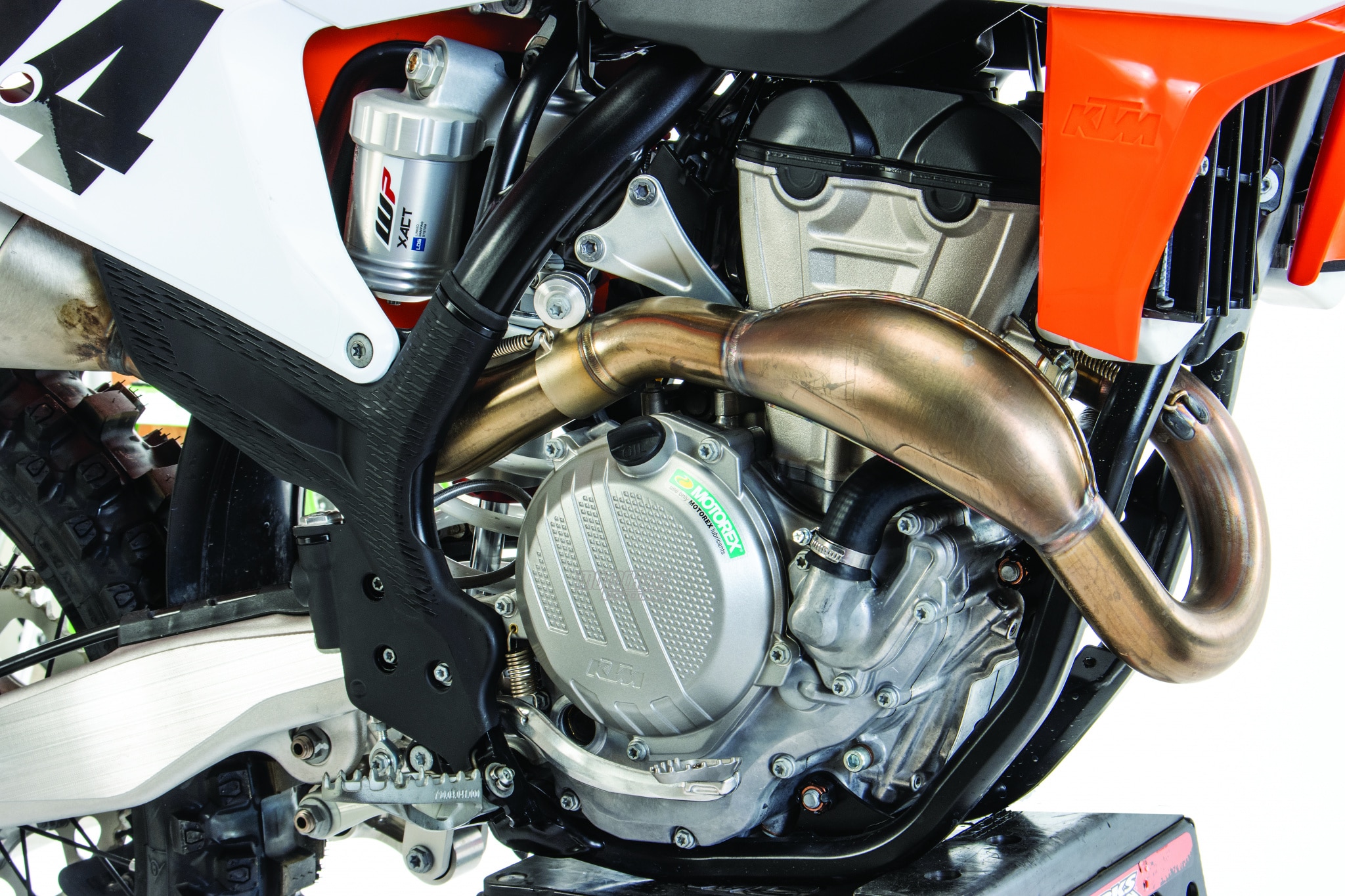
Q: WHAT’S NEW ON THE WP SHOCK?
A: You might be surprised to learn that:
(1) Valving. The shock valving is different on the KTM 450SXF, 350SXF and 250SXF. And, the 2021 KTM 350SXF has slightly stiffer valving than the 450SF, while the 250SXF is considerably softer.
(2) Length. KTM did not shorten its suspension, as Husqvarna did for 2021. The Husky forks are 10mm shorter, and the Husqvarna has longer shock linkage arms (0.5mm), a revised bell crank, and a 6mm longer seal cap that limits travel from 140mm to 134mm.
(3) Spring rate. You might think that the 350SXF and 450SXF would share the same 45 N/mm spring, but they don’t. The 350SXF and 250SXF come with 42 N/mm shock springs.
(4) Linkage seals. KTM spec’ed SKF seals for the shock linkage to make it freer moving.
(5) Bushing support. There is a new Viton O-ring behind the bushing on the shock piston. The previous O-ring would deform from constant use and not ensure a solid seal between the bushing and shock body. The new O-ring will not deform.
Q: WHAT DID KTM DO TO THE 2021 350SXF MAPPING?
A: Two years ago, we tested a KTM map that was much better than what KTM was offering in 2019. It was called the “American map.” We felt that KTM would adopt this map. It didn’t. Oh, KTM moved in that direction, but at a glacial pace. On the 2021 KTM 350SXF, Map 2 was improved, especially in the midrange, but it wasn’t as crisp or responsive as Map 2 on the 2021 KTM 450SXF; however, when the racetrack was loamy and soft, we ran Map 2, and when the track was dry, hard and sketchy, we ran Map 1. We also often ran either map with traction control engaged.
Q: HOW DOES IT FEEL ON THE TRACK?
A: The 2021 KTM 350SXF feels like a thing of beauty. It has a great powerband. It picks up quickly down low, pulls steady through the middle and revs to an amazing 13,400 rpm rev limiter. The 2021 KTM 350SXF makes 54.60 horsepower, along with 29.40 pound-feet of torque, which is more peak horsepower than the 2021 Suzuki RM-Z450 makes; however, to get the best out of the KTM 350SXF engine, you have to rev it to the moon. The best advice for first-time 350SXF riders is don’t shift. Of course, we don’t mean never shift, just don’t shift until the rpm peaks out. That’s a lot higher than your brain tells you.
Q: WHAT DID WE HATE?
A: The hate list:
(1) Seat height. Motocross bikes keep getting taller. If you are under 5-foot-9, there is a good chance that your feet won’t touch the ground; however if you want a lower version of the KTM 350SXF, buy the 2021 Husqvarna FC350; it is an inch lower at the rear of the seat.
(2) Spokes. Our spokes never took a set. Every couple motos we would check the spoke next to the rim lock and it would be loose. If it’s loose, the other spokes will be loose very soon.
(3) Checklist. Check the bolts on the rear sprocket, shift lever, shock linkage, head stays and hydraulic clutch slave unit at regular intervals.
(4) Compression clicker. We don’t need more or fewer prongs, we need longer prongs.
(5) On the stand. When the KTM 350SXF is sitting on a bike stand, the front wheel is hitting the ground. It’s a hassle for simple maintenance and washing. KTM isn’t the only brand with this issue.
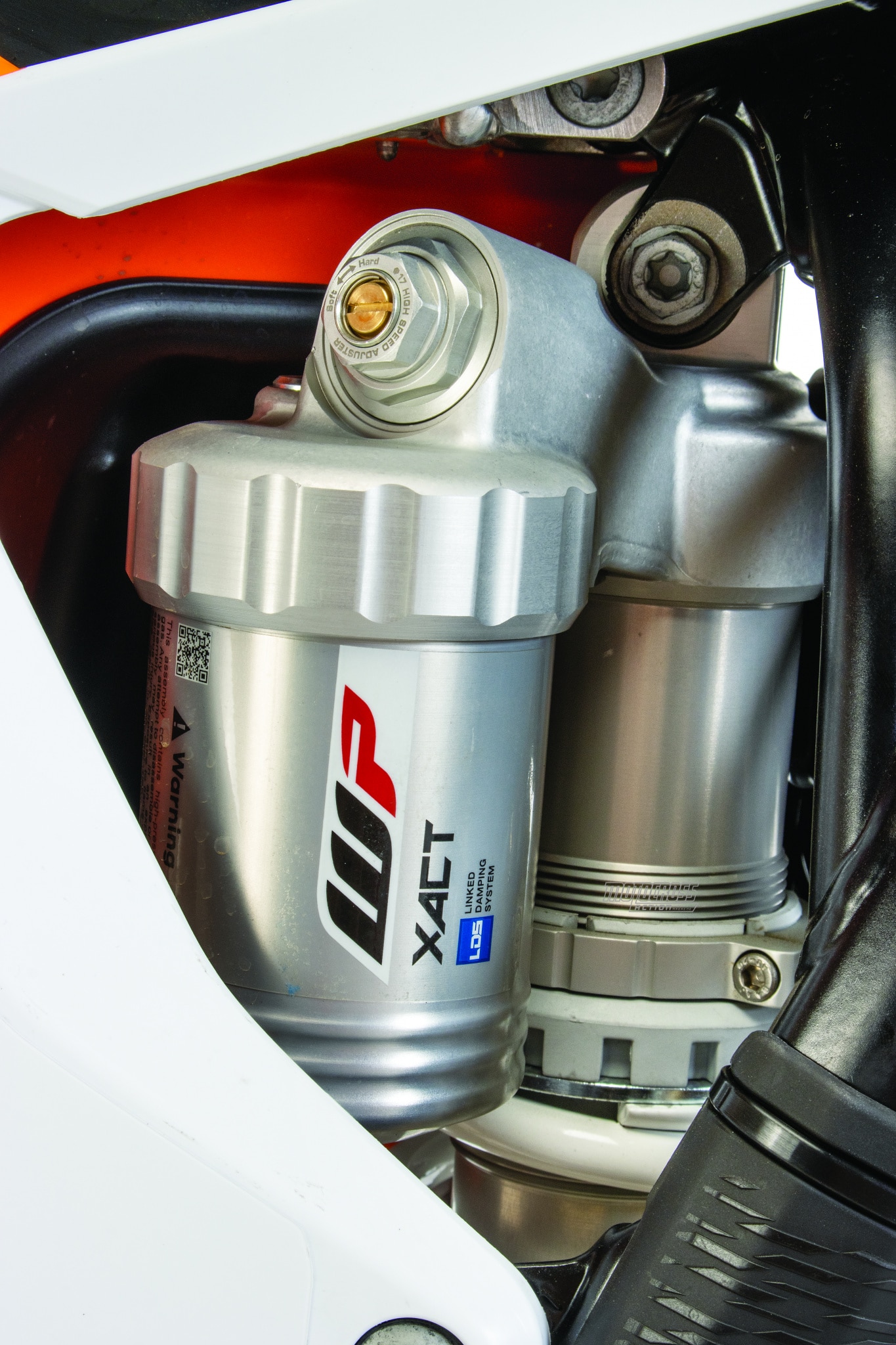
Q: WHAT DID WE LIKE?
A: The like list:
(1) Brembo hydraulic clutch. We like the “pop” feel of the Brembo master cylinder.
(2) Brembo brakes. Some day Nissin will catch up to Brembo when it comes to well-modulated, powerful and one-finger braking, but it isn’t going to be this year.
(3) Weight. The 2021 KTM 350SXF weighs 222 pounds, and while that is only 1 pound less than the KTM 450SXF, it is 6 pounds less than a Honda CRF250. As for its close proximity to the 450SXF’s 223-pound weight, the lighter rotating mass of the 350SXF engine cranks, cams, piston and drivetrain make it feel much lighter than the 1-pound difference.
(4) Throttle cam. Your KTM 350SXF sat on the showroom floor with the stock, long-throw throttle cam installed. Put on the quick-turn black throttle cam that came with your bike.
(5) Air filter. We love how foolproof it is to put a KTM air-filter cage into the airbox. No gymnastics required.
(6) Linkage seals. We drop tested a 2021 SKF-equipped linkage against last year’s linkage. The SKF-equipped link was much smoother.
(7) Tires. For 2021, Dunlop MX33 motocross tires replace last year’s MX3S tires. We have warm feelings towards the MX3S front tire, even if it does chunk knobs.
(8) Gasoline. The KTM 350SXF is tuned to run on 91-octane American fuel. If you modify your engine, increase the compression, or switch black boxes, then you might need better fuel. Until then, run the highest-octane pump gas that you can find at the busiest gas station in your town.
(9) Vented airbox. Don’t run the vented airbox cover on dusty or rainy days; run it on days when you could use extra power. Cover the vents with duct tape before washing your bike.
(10) Mapping. The 350SXF comes with two distinctly different maps that can be used in conjunction with both Launch Control and Traction Control—and they are easy to access (except for Launch Control, which requires some digital gymnastics).
Q: WHAT DO WE REALLY THINK?
A: If you’re on the fence about which is the best all-around motocross bike made—get off the fence and beg, borrow or steal a ride on a 2021 KTM 350SXF. It is the best all-around motocross bike made.

MXA’S 2021 KTM 350SXF SETUP SPECS
This is how we set up our 2021 KTM 350SXF for racing. We offer it as a guide to help you find your own sweet spot.
AER FORK SETTINGS
The 2021 WP Xact air forks will change your mind about air forks. The 2021 forks are plush, supple and offer the feel of a coil-spring fork while being 3 pounds lighter. To get that feel, you have to find your perfect air pressure and do all additional tuning with the clickers. For hardcore racing, we recommend this fork setup for an average rider on the 2021 KTM 350SXF (stock specs are in parentheses):
Spring rate: Pros, 10.6 bar (155 psi); Intermediates, 10.3 bar (150 psi); Fast Novices, 10.0 bar (145 psi); Novices/Vets, 9.6 bar(140 psi)
Compression: 15 clicks out (12 clicks out stock)
Rebound: 10 clicks out (12 clicks out stock)
Fork-leg height: Third line
Notes: Don’t be afraid to go higher or lower on the air pressure. Bleed the outer chambers at regular intervals. Reset the air pressure to your chosen settings between motos (once the forks have cooled down from riding).
WP SHOCK SETTINGS
Most MXA test riders added more high-speed compression and more rebound. MXA test riders don’t stray far from the stock 15 clicks out on low-speed compression, relying on the high-speed and rebound adjustments to have a crossover effect on the whole shock. For hardcore racing, we recommend this shock setup for the 2021 KTM 350SXF (stock specs are in parentheses):
Spring rate: 45 N/mm
Race sag: 105mm
Hi-compression: 1-1/4 turns out (1-1/2 turns out stock)
Lo-compression: 15 clicks out
Rebound: 10 clicks out (15 clicks out stock)
Notes: We turned the high-speed compression damping in a 1/4 turn to lessen G-outs and run more rebound than the recommended setting.


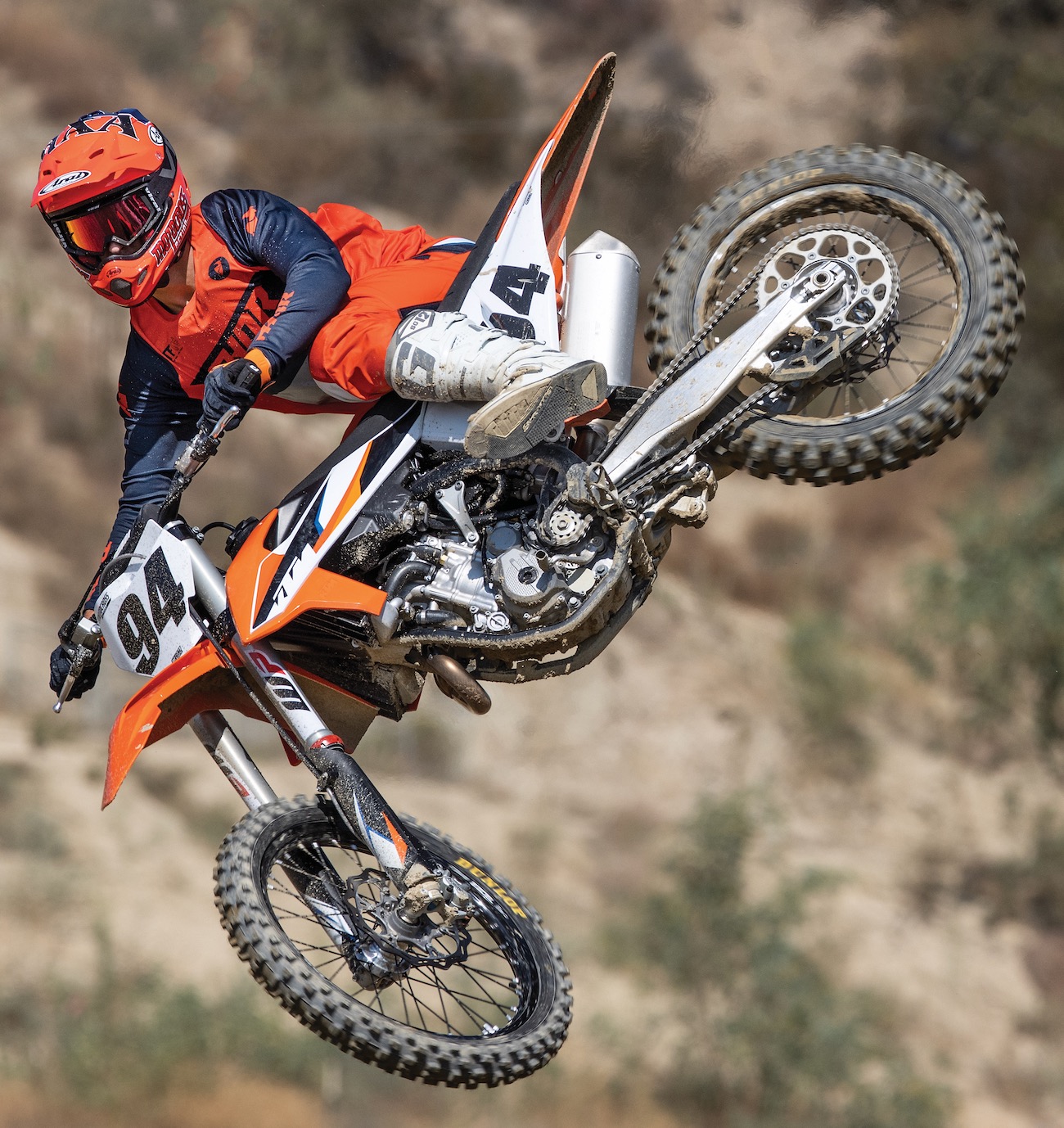

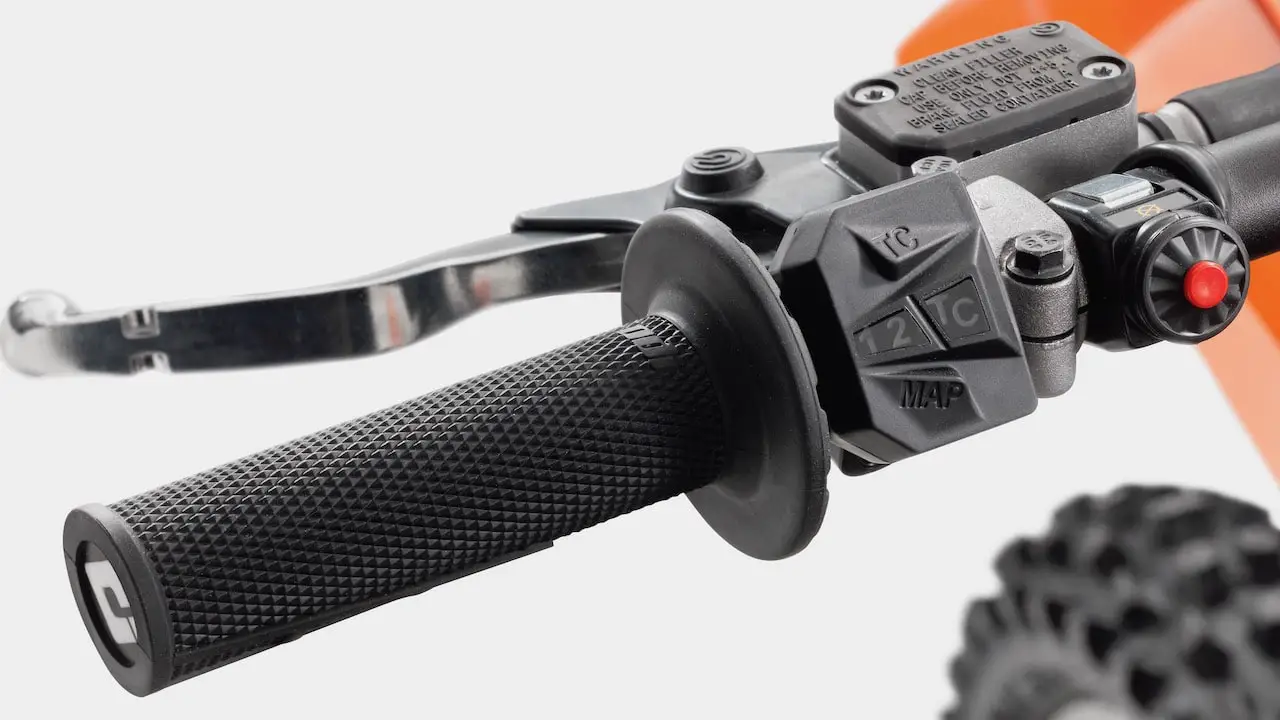



Comments are closed.